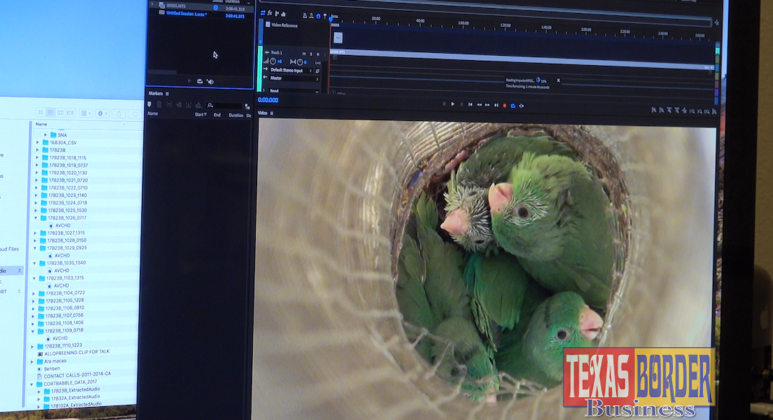Texas Border Business
By Maria Elena Hernandez
RIO GRANDE VALLEY, TEXAS – UTRGV graduate student Caleb Arellano is reviewing thousands of hours of videos to study sibling interaction. Except he can’t understand what they’re saying.
The siblings he’s studying are green-rumped parrotlets, animal models used to research vocal babble.
“While it’s true most animals vocalize, only a few types learn their vocalizations … usually a juvenile listening to a tutor, usually a parent, listening to it, processing what the parent is vocalizing inside their head and then trying to imitate it and attenuating that imitation until they get it just right,” Arellano said.
“A really good example of animals that learn their vocalizations are, actually, human beings.”
You’ve probably witnessed the “ga-ga goo-goo” stage in babies.
Dr. Karl Berg, assistant professor in the UTRGV College of Sciences Department of Biology, says the vocal babbling stage gets very complex right before the first word of the native language articulated by the baby.
“And the complexity of the acoustic structure of the vocal babbling signals apparently can give you insights into cognitive development and how the child is going to do later in life.”
Berg was working in Venezuela at the site of the world’s longest ongoing study of any wild parrot populations when he heard something unexpected in a nest. The nests are equipped with cameras and microphones for researchers to monitor the parrots.
“The parents weren’t around, and it usually means the nestlings kind of are asleep, and they don’t do a whole lot,” he said.
But, when he put on headphones to listen in, “There was like this singing inside the nest. … So I got really excited when I saw that, because it was late in development, not unlike vocal babbling.”
The chicks vocalizing to each other was a chance to study a popular, but untested, hypothesis about how social bonds can influence early cognitive development.
Berg said, “We can ask, ‘Does growing up with one or two siblings change how you manifest cognitive behaviors later in life, as opposed to growing up with 11 brothers or sisters?’”
To help get the answers, the National Science Foundation has awarded Berg more than half a million dollars to study sibling influences on vocal babbling and development.
“We jumped at the opportunity to look at this in a natural population,” he said.
The recordings Arellano is reviewing, which National Geographic Society funded, are from the research site in Venezuela.
“He’s actually been working for several years with the video,” Berg said, “quantifying how the individuals interact with each other. We’re interested to see whether individuals interacting with more siblings are inclined to develop a richer vocal babbling repertoire.”
To learn about more research underway at the UTRGV Department of Biology, visitutrgv.edu/biology/research.














